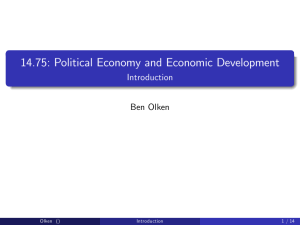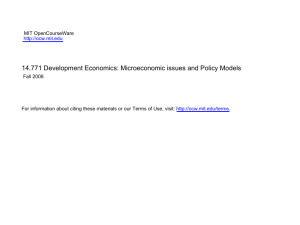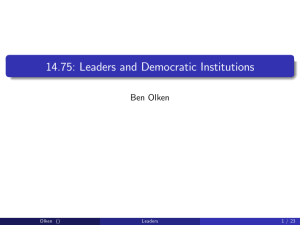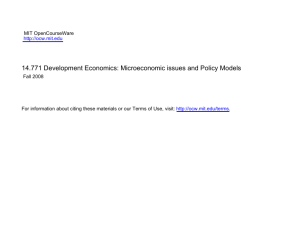14.771 Development Economics: Microeconomic issues and Policy Models MIT OpenCourseWare Fall 2008
advertisement
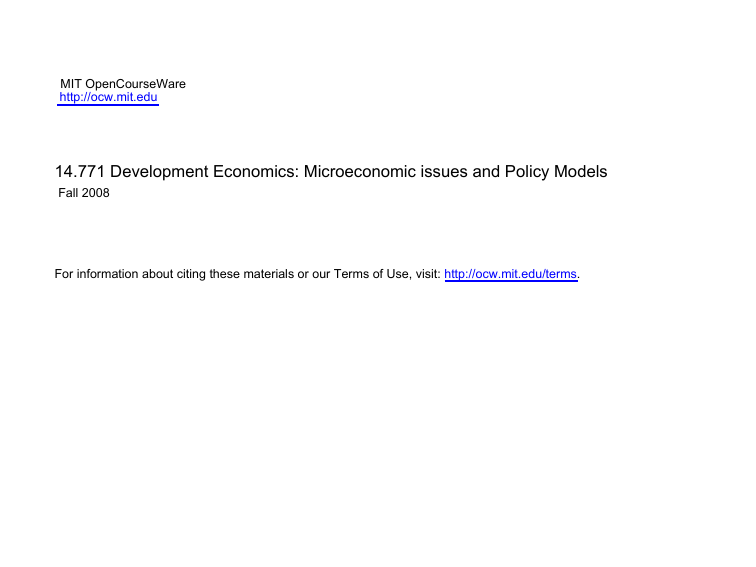
MIT OpenCourseWare http://ocw.mit.edu 14.771 Development Economics: Microeconomic issues and Policy Models Fall 2008 For information about citing these materials or our Terms of Use, visit: http://ocw.mit.edu/terms. 14.771: Public Finance Lecture 1 Ben Olken October 2008 Olken () PF Lecture 1 10/08 1 / 25 Outline Topics I will talk brie‡y about: Tax (today) Market failures (today) Correcting externalities Providing public goods Redistribution (next lecture) Topics I won’t talk about at all: Social insurance Regulation Federalism, decentralization, and local public goods (among many other things) Note: Very little work in this area. Good area for research! Olken () PF Lecture 1 10/08 2 / 25 Tax There is a vast literature in PF on taxation. E.g., incidence, optimal income tax theory, capital taxation, consumption taxes, dynamic considerations, etc, etc. By comparison we know very little about tax – either theory or empirics – in developing countries. What we do know suggests that there is a fundamental di¤erence between developing and developed countries: Information. There is much less information available. How do you levy an income tax on people who are subsistence farmers? Or laborers in an all-cash economy? Enforcement. Given the information problems there is substantial opportunity for corruption. Olken () PF Lecture 1 10/08 3 / 25 Tax As a result of information and enforcement problems, tax the tax structure in developing countries looks very di¤erent than in developed countries, because you need to tax things with high information and low elasticites of evasion (Gordon and Li 2005) Olken () PF Lecture 1 10/08 4 / 25 Developed and developing countries tax structure GDP per capita Tax revenue (% of GDP) Income Corporate Consumption and income taxes production tax (% of (% of taxes (% of revenue) income revenue) taxes) Border taxes (% of revenue) Inflation Seignorage income rate (% of revenue) Informal economy (% of GDP) < $745 14.1 35.9 53.7 43.5 16.4 10.6 21.8 26.4 $746-2,975 16.7 31.5 49.1 51.8 9.3 15.7 24.9 29.5 $2,976-9,205 All developing 20.2 17.6 29.4 31.2 30.3 42.3 53.1 51.2 5.4 8.6 7.4 11.8 6.0 16.3 32.5 30.1 > $9,206 25.0 54.3 17.8 32.9 0.7 2.2 1.7 14.0 Figure by MIT OpenCourseWare. from Gordon and Li (2005) Olken () PF Lecture 1 10/08 5 / 25 Tax As a result of information and enforcement problems, tax the tax structure in developing countries looks very di¤erent than in developed countries, because you need to tax things with high information and low elasticites of evasion (Gordon and Li 2005) Smaller: 2/3 the size of tax revenue in rich countries as percentage of GDP Income taxes focus on corporate, not individual. Tari¤s and seigniorage play non-trivial role much more important Olken () PF Lecture 1 10/08 6 / 25 Explanation One explanation: information (Gordon and Li 2005). Using the …nancial sector generates information for the government. Taxes focus on corporate because the large corporations are inelastic in their use of the formal banking system, so this is where taxes are focused. Tari¤s protect the taxed sector. In‡ation taxes the cash economy. Seems intuitive, but far from the last word on the subject. Olken () PF Lecture 1 10/08 7 / 25 Informal taxation Olken and Singhal (2008) study phenomenon of ’voluntary’ contributions to local public goods Harambee in Kenya Gotong Royong in Indonesia Idea: taxation analogue of informal insurance Speci…cally, local communities have good information about incomes, but face enforcement constraints They can therefore enforce ’voluntary’contributions to public goods – what we call informal taxation – through social sanctions Within communities, rich pay more, but less as a share of expenditure, so it is regressive Social sanctions less potent in richer, urban areas so this is primarily a rural phenomenon On net: makes tax system more regressive Olken () PF Lecture 1 10/08 8 / 25 Informal taxation To examine who pays di¤erent types of taxes, we run Fan locally-weighted regressions of taxes as share of expenditure against expenditure per equivalent adult 8 .8 4 6 % of expenditure Density .4 4 6 % of expenditure .6 8 .6 .4 .2 Density 11 12 13 Log equivalent expenditure Informal taxes Direct formal taxes 14 2 3 Total formal taxes Density 4 5 Log equivalent expenditure Informal taxes Direct formal taxes 0 11 Total formal taxes Density 12 13 14 Log equivalent expenditure Informal taxes Direct formal taxes 15 Total formal taxes Density 6 6.5 7 7.5 8 Log equivalent expenditure Informal taxes Direct formal taxes Olken () 8.5 Total formal taxes Density 2 3 % of expenditure .6 1 0 0 0 0 .2 .2 Density .4 Density .4 .6 1 2 % of expenditure 4 .8 .8 5 Vietnam 2002 3 Philippines 6 0 0 2 2 .2 10 0 0 0 2 .2 Density .4 4 6 % of expenditure .6 8 .8 Indonesia 2007 10 Ethiopia 10 Albania 5 6 7 Log equivalent expenditure Informal taxes Direct formal taxes 8 Total formal taxes Density PF Lecture 1 10/08 9 / 25 How big is evasion? Fisman and Wei (2004): what is the ’elasticity’of tax evasion with respect to tax rates? Empirical challenge: very hard to measure what the true tax assessment should be. Fisman and Wei’s idea: Look at both sides of the China - Hong Kong border, where China is the ’high evasion’side and Hong Kong is the ’low evasion side’ Denote the di¤erence between what Hong Kong (low corruption) and China (high corruption) reports as evasion, i.e, gap_value = log (export_value) log (import_value) Key regressions: gap_valuek = α + β1 taxk + εk gap_valuek = α + β1 taxk + β2 tax_ok + εk Olken () PF Lecture 1 10/08 10 / 25 Effect of Tax Rates on Evasion (Measured in Value) Regression Tax rate Constant Excluding outliers? Excluding products lacking tax on similar products? Excluding products lacking observations on quantities? Observations R2 (1) (2) (3) (4) (5) (6) (7) 2.93 2.46 3.21 3.57 2.98 2.61 3.4 (.74) -1.31 (.67) -1.04 (.87) -1.31 (.89) -1.48 (.81) -1.29 (.79) -1.12 (.96) -1.46 (.29) (.23) (.30) (.31) (.29) (.27) (.34) no yes no no yes yes yes no no yes no no yes yes no no no yes yes no yes 1,663 1,639 1,470 1,102 1,087 1,450 968 .020 .017 .022 .031 .025 .017 .029 Note: The dependent variable is log (value of exports from Hong Kong to China) - log (value of imports to China from Hong Kong). Robust standard errors are in parentheses, accounting for clustering of standard errors by four-digit HS. Figure by MIT OpenCourseWare. Incorporating the Average Tax on Similar Products Dependent Variable: Log (Value of Exports from Hong Kong to China) - Log (Value of Imports to China from Hong Kong) Regression (1) Constant (3) (4) (5) 6.07 5.31 8.32 7.46 (1.37) (1.25) (1.56) (1.42) 2.62 -3.16 -2.98 -4.65 -4.45 (.90) (1.39) (1.33) (1.58) (1.53) -1.09 -1.20 -1.02 -1.56 -1.33 Tax rate Tax on similar products (2) (.034) (.31) (.28) Excluding outliers? no no yes no yes Excluding products lacking observations on quantities? no no no yes yes 1,470 1,470 1,450 981 968 Observations R2 .014 .025 .020 (.38) .041 (.35) .035 Note: Robust standard errors are in parentheses, accounting for clustering of standard errors by four-digit HS. Figure by MIT OpenCourseWare. Empirical issues to think about Are tax rates endogenous? They should be: governments should understand that there is di¤erential elasticities and set lower tax rates on more elastic (easier to evade) items. This paper assumes government is naiive. How would sophisticated government bias results? Is spillover model mis-speci…cied? Recall they include all products in category, but products vary in size. Suppose in a category you have one very large product and very small product. Small shift out of large product is a large proportional shift into small product. Might have been better to include only one product per category? Or model this explicitly? Olken () PF Lecture 1 10/08 13 / 25 Tax That’s it! (Not quite, but you get the point) Olken () PF Lecture 1 10/08 14 / 25 Correcting externalities Basic public …nance theory: use taxes and subsidies to correct externalities. These taxes and subsidies are permanent: as long as the externality remains, you need the tax/subsidy in place to correct it. Optimal tax/subsidy depends on degree of externality, elasticity of supplying externality, and marginal cost of public funds Many in development design policies for ’sustainability.’ Idea is that there are multiple equilibria, so a one time intervention can lead to a ’sustainable’outcome. Is this plausible? Olken () PF Lecture 1 10/08 15 / 25 The Illusion of Sustainability Kremer and Miguel (2007) Setting: Deworming in Kenya. Disease transmission implies very large positive externalities from deworming Research design: randomized experiment to Test elasticity of demand for deworming drugs by introducing cost-sharing (at approx. 20% of actual average cost) Test whether social adoption spillovers are positive (this could help generate multiple equilibria) Olken () PF Lecture 1 10/08 16 / 25 Experimental Design Kremer and Miguel (2007) experimental design: Kremer and Miguel (2007) basic experimental design 1998 1999 2000 2001 Group 1 (25 schools) Free Treatment Free Treatment Free Treatment Free Treatment Group 2 (25 schools) Control Free Treatment Free Treatment Free Treatment Group 3 (25 schools) Control Control Control Free Treatment Cost-Sharing Cost-Sharing Examine Groups 2 and 3 in 2001. Collect data on usage and average number of links to households in di¤erent experimental treatments Estimate Probit model with errors clustered by school: 0 P (Tij = 1) = Φ NijE a + Nij b1 + b2 COSTj + Zij0 b3 Olken () PF Lecture 1 10/08 17 / 25 Results on cost sharing Courtesy of MIT Press. Used with permission. Olken () PF Lecture 1 10/08 18 / 25 Cost calculation Cost per-pupil under full subsidy: US $1.478 Cost per-pupil under cost sharing US $1.374 Assumes $15 per school …xed cost, US$0.03 marginal cost to collect funds, and US$0.30 cost sharing Assume …xed budget B Extra students treated with cost-sharing: B B = B 0.0512 1.374 1.478 Extra revenue collected from cost-sharing: B US $0.30 = B 0.2183 1.374 Marginal social cost of additional student treated: B 0.2183 = US $4.26 B 0.0512 Marginal cost of public funds would need to be greater than 4.26! Olken () PF Lecture 1 10/08 19 / 25 Results on social spillovers Courtesy of MIT Press. Used with permission. Table 4, Experimental Social Effect Estimates, in Kremer, Michael, and Edward Miguel. “Illusion of Sustainability.” Quarterly Journal of Economics 122, no. 3 (2007): 1007-1065. Olken () PF Lecture 1 10/08 20 / 25 Implications Very price elastic: introducing cost sharing dramatically reduces take-up Suggests probably more e¤ectively …nanced out of general public funds than out of user fees Social spillovers (in this case) are negative, which leads in direction of single equilibrium Consistent with many other …ndings of very high price-elasticity for health (including those discussed by Esther): Cohen and Dupas (2007) Banerjee et al. (2008) Olken () PF Lecture 1 10/08 21 / 25 Public goods Public good de…nition: non-rival, non-excludable goods In practice, government also provides other types of goods with large …xed costs: Dams Electric power Airports Issues to think about in developing countries: Return and willingness to pay – does social return exceed social cost? Distributional impacts? What level of government should provide? Does Tiebout sorting model apply in developing countries? Corruption? Olken () PF Lecture 1 10/08 22 / 25 Dams Du‡o and Pande (2007) Setting: Irrigation dams provide irrigation downstream, impose costs upstream. Key questions: What is overall e¤ect of the dams? Do transfers happen? Empirical idea: Gradient of river determines whether a site is a good candidate for a dam. Intermediate slope best for irrigation dams, Use national trends in dam construction, times initial share of dams in state, to estimate number of new dams built in state in a year. Instrument is the interaction of predicted dams built in state with river gradient in district to get ’predicted new dams in district’ Is exclusion restriction valid? Olken () PF Lecture 1 10/08 23 / 25 Results Courtesy of MIT Press. Used with permission. From Table 7, Dams and Rural Welfare, in Duflo, Esther, and Rohini Pande. “Dams.” Quarterly Journal of Economics 122, no. 2 (2007): 601-646. Olken () PF Lecture 1 10/08 24 / 25 Results Positive e¤ects on agriculture in downstream districts, (potentially) negative e¤ects in district with dam Reductions in poverty in downstream districts, increases in poverty in district with dam So transfers are not happening In fact, increases in poverty in district with dam exceed reductions in poverty in downstream districts Reductions in log per-capita expenditure are 0.289 OLS, 0.457 IV Increases only 0.093 OLS, 0.142 IV. 1.75 times as many downstream as upstream, so average log per-capita expenditure goes down. Also note log dependent variable makes ’adding up’hard to do, so transfers might still be possible. Note: are these estimates too large? Olken () PF Lecture 1 10/08 25 / 25
